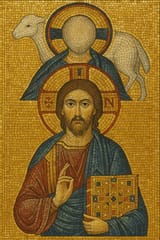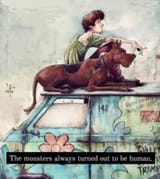Anonymous
6/10/2025, 6:30:06 PM No.33198631
The traditional depiction of Jesus as "the lamb" is theologically reductive and symptomatic of a epistemic failure that began with the synthesis of early Christianity and classical Greco-Roman pedagogy.
The Hellenic philosophers, particularly the Platonists and Stoics, sought to order reality through rational abstraction and categorical distinction. When early Church fathers attempted to reconcile the explosive, erotic nature of Christ they committed a subtle but devastating act of mistranslation. Christ, originally a symbol of radical disruption and divine transgression, was reinterpreted as a sacrificial figure that conveniently aligned with Neo-Platonic idealism about civic order.
In this framework, the "lamb" became a moral archetype for submission, purity, and obedience. But the lamb, properly understood, was NOT Christ. The lamb IS a cipher for the Holy Spirit: the numinous, indeterminate presence in the Trinity. It is not the figure who dies but the one who eludes, inspires, haunts. A ghost does not submit. A ghost disturbs.
The educational institutions that emerged under the influence of this distorted view continue to push rote memorization of doctrine rather than allowing children to ponder divine paradox.
At this point, I am less interested in arguing the point than in implementing a correction. I am willing to do the research, compile the footnotes, and construct the curriculum. What I need is guidance on strategy: How can I get the most schools, private, public, religious, or charter, to even consider teaching a corrected anti-Ovine Christology? Where is the best cultural toehold to begin? If I can gain the interest of even one serious academic or administrator, I will build the scaffolding myself. Just point me toward the most efficient breach point in the system for heterodox truth.
The Hellenic philosophers, particularly the Platonists and Stoics, sought to order reality through rational abstraction and categorical distinction. When early Church fathers attempted to reconcile the explosive, erotic nature of Christ they committed a subtle but devastating act of mistranslation. Christ, originally a symbol of radical disruption and divine transgression, was reinterpreted as a sacrificial figure that conveniently aligned with Neo-Platonic idealism about civic order.
In this framework, the "lamb" became a moral archetype for submission, purity, and obedience. But the lamb, properly understood, was NOT Christ. The lamb IS a cipher for the Holy Spirit: the numinous, indeterminate presence in the Trinity. It is not the figure who dies but the one who eludes, inspires, haunts. A ghost does not submit. A ghost disturbs.
The educational institutions that emerged under the influence of this distorted view continue to push rote memorization of doctrine rather than allowing children to ponder divine paradox.
At this point, I am less interested in arguing the point than in implementing a correction. I am willing to do the research, compile the footnotes, and construct the curriculum. What I need is guidance on strategy: How can I get the most schools, private, public, religious, or charter, to even consider teaching a corrected anti-Ovine Christology? Where is the best cultural toehold to begin? If I can gain the interest of even one serious academic or administrator, I will build the scaffolding myself. Just point me toward the most efficient breach point in the system for heterodox truth.
Replies:

